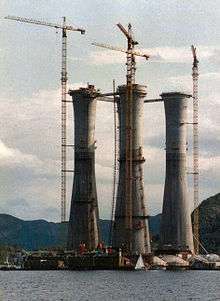Condeep
Condeep is a make of gravity-based structure for oil platforms developed by engineer Olav Mo in Hoeyer-Ellefsen and fabricated by Norwegian Contractors in Stavanger, Norway.[1][2][3] Condeep is an abbreviation for concrete deep water structure. A Condeep usually consists of a base of concrete oil storage tanks from which one, three or four concrete shafts rise.[4] The Condeep base always rests on the sea floor, and the shafts rise to about 30 meters above the sea level. The platform deck itself is not a part of the construction.

The Condeep is used for a series of production platforms introduced for crude oil and natural gas production in the North Sea and Norwegian continental shelf.[1]
Following the success of the concrete oil storage tank on the Ekofisk field, Norwegian Contractors introduced the Condeep production platform concept in 1973.[5]
This gravity-based structure for a platform was unique in that it was built from reinforced concrete instead of steel, which was the norm up to that point. This platform type was designed for the heavy weather conditions and the great water depths often found in the North Sea.[1]
Condeep has the advantage that it allows for storage of oil at sea in its own construction. It further allows equipment installation in the hollow legs well protected from the sea. In contrast, one of the challenges with steel platforms is that they only allow for limited weight on the deck compared with a Condeep where the weight allowance for production equipment and living quarters is seldom a problem.
Troll A
The Troll A platform is the largest Condeep to date.[6] It was built over a period of four years, using a workforce of 2,000, and deployed in 1995 to produce gas from the enormous Troll oil field.
With a total height of 472 meters, Troll A was the tallest structure ever to be built and then moved in its entirety. Many sources erroneously state that it is the largest structure of any kind. The largest structure ever moved (also a Condeep) was the Gullfaks C platform in the Norwegian North Sea. The total weight of the Troll A Condeep when launching was 1.2 million tons. 245,000 m³ of concrete and 100,000 tons of steel for reinforcement were used.[7] The amount of steel corresponds to 15 Eiffel towers.[7] The platform is placed at a depth of 300 meters. For stability, it is dug 35 meters into the sea floor.
Condeep Platforms
| Structure | Depth | Operator and year |
|---|---|---|
| Beryl A Condeep | 120 m | Mobil, 1975 |
| Brent B Condeep | 140 m | Shell, 1975 |
| Brent D Condeep | 140 m | Shell, 1976 |
| Frigg TCP2 Condeep | 104 m | Elf, 1977 |
| Statfjord A Condeep | 146 m | Mobil, 1977 |
| Statfjord B Condeep | 146 m | Mobil, 1981 |
| Statfjord C Condeep | 146 m | Mobil, 1984 |
| Gullfaks A Condeep | 135 m | Statoil, 1986 |
| Gullfaks B Condeep | 142 m | Statoil, 1987 |
| Oseberg A Condeep | 109 m | Norsk Hydro, 1988 |
| Gullfaks C Condeep | 216 m | Statoil, 1989 |
| Draugen Condeep | 251 m | Shell, 1993 |
| Sleipner A Condeep | 82 m | Statoil* |
| Troll Condeep | 303 m | Norske Shell, 1995 |
- The original concrete structure of Sleipner A sank during trials in the Gandsfjord on August 23, 1991. A new structure was built, and deployed in 1993.
Sources
- Fagerberg, Jan; Mowery, David C.; Verspagen, Bart (2009). Innovation, Path Dependency, and Policy: The Norwegian Case. Oxford University Press US. ISBN 978-0-19-955155-2.
- Nawy, Edward G. (2008). Concrete construction engineering handbook. CRC Press. ISBN 978-0-8493-7492-0.
- Mehta, Povindar K. (1990). Concrete in the marine environment. Taylor & Francis. ISBN 978-1-85166-622-5.
- Gerwick, Ben C. (2007). Construction of marine and offshore structures. CRC Press. ISBN 978-0-8493-3052-0.
- Arentsen, Maarten J.; Künneke, Rolf W. (2003). National reforms in European gas. Gulf Professional Publishing. ISBN 978-0-08-043687-6.
References
- Fagerberg; Mowery; Verspagen, p.192
- Mehta, Povindar K. p.4
- Gerwick, Ben C. p.166
- Dr. techn. Olav Olsen, Condeep platforms Archived 2011-09-27 at the Wayback Machine, (in Norwegian) 2011, web page by Norwegian Petroleum Directorate, retrieved 2011-08-30
- Arentsen; Künneke p. 90
- Fagerberg; Mowery; Verspagen, p.191
- "Guinness World Records - tallest offshore gas platform". Guinness World Records. 1996.
- Nawy, Edward G. Chapter 13.7
- Gerwick, Ben C. p.515